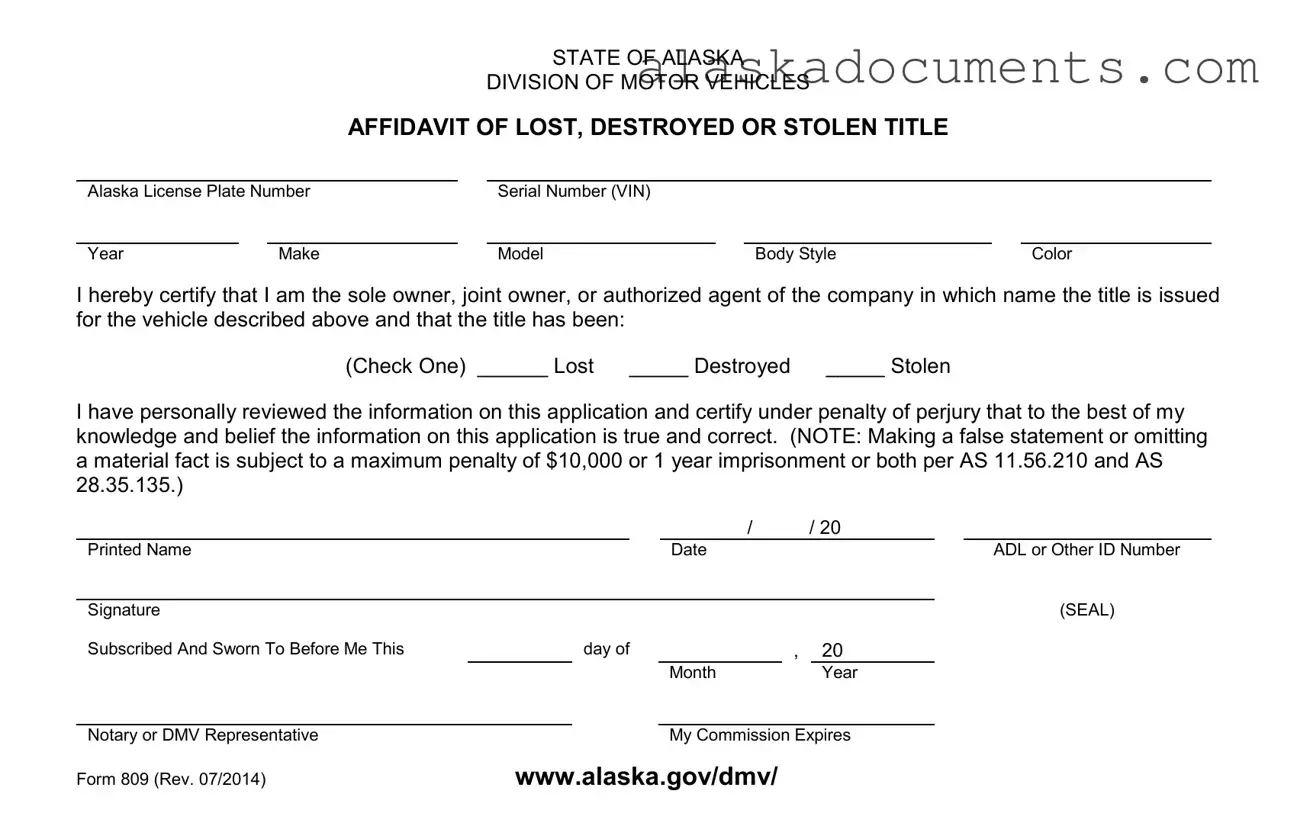The Alaska 809 form is similar to the Affidavit of Title Loss form used in many states. This document serves a similar purpose, allowing vehicle owners to declare that their title has been lost, destroyed, or stolen. Like the Alaska 809, it requires the owner to certify their ownership and the status of the title. Both forms emphasize the importance of providing accurate information under penalty of perjury, reinforcing the legal implications of submitting false statements.
Another comparable document is the Application for Duplicate Title. This form is often used when a vehicle owner needs a replacement title due to loss or damage. Similar to the Alaska 809, it requires details about the vehicle, including the VIN and owner information. The applicant must also affirm their ownership and the circumstances surrounding the need for a duplicate title, ensuring that the process is secure and legitimate.
The Bill of Sale is another document that shares similarities with the Alaska 809 form. While primarily used for the transfer of ownership, it can also serve as proof of ownership when a title is lost. A Bill of Sale includes details about the vehicle and the parties involved. Both documents require signatures and can be notarized to add an extra layer of authenticity, helping to protect against fraud.
When dealing with the complexities of vehicle ownership and transfer, it's essential to utilize the appropriate documents, such as the Bill of Sale, which is integral for establishing ownership. Additionally, a https://smarttemplates.net/ Bill of Sale form can provide clarity and legitimacy to the transaction, ensuring that all parties involved have a formal record of the sale, thereby avoiding potential disputes in the future.
The Vehicle Registration Application is also relevant in this context. This form is used to register a vehicle with the state, and it often requires proof of ownership, such as a title. If the title is missing, the Alaska 809 can be submitted alongside the registration application. Both documents help ensure that the vehicle is properly documented and that ownership is clearly established.
The Affidavit of Heirship can be compared to the Alaska 809 form in cases where a vehicle title is lost after the owner's death. This document is used to establish the rightful heir to the vehicle. Similar to the Alaska 809, it requires a sworn statement and often needs to be notarized. Both forms aim to clarify ownership and prevent disputes over property rights.
The Lost Title Affidavit is another document that parallels the Alaska 809 form. This affidavit is typically used to declare that a title has been lost and to request a replacement. Like the Alaska 809, it requires the owner to provide specific vehicle details and affirm their ownership. Both forms serve as legal declarations to facilitate the issuance of new titles while safeguarding against fraudulent claims.
The Statement of Facts is also relevant here. This document is used to clarify specific circumstances regarding vehicle ownership or registration. When a title is lost, a Statement of Facts can accompany the Alaska 809 to provide additional context. Both documents require truthful information and can be used to support claims made in other vehicle-related applications.
Lastly, the DMV Affidavit is similar to the Alaska 809 form. This document is often used for various purposes related to vehicle ownership, including lost titles. It requires a sworn statement from the vehicle owner, similar to the Alaska 809. Both forms are designed to protect the integrity of vehicle transactions and ensure that ownership is accurately recorded in state databases.

